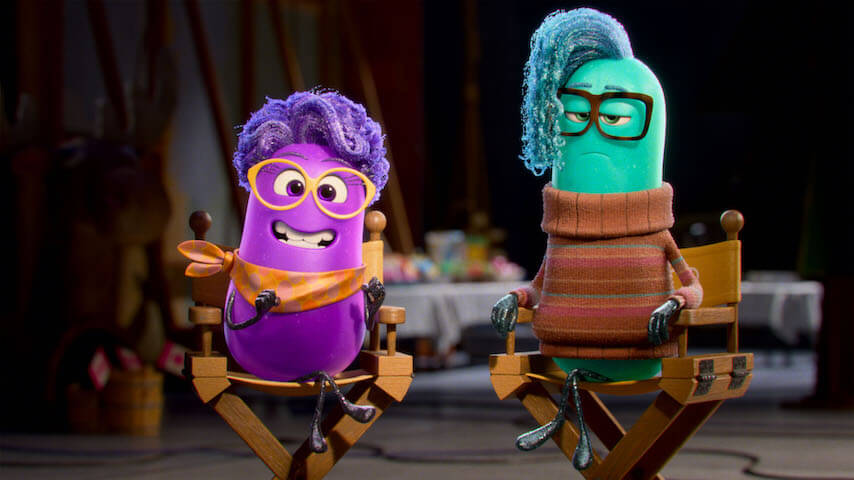Now Reading: A meta Inside Out spin-off
-
01
A meta Inside Out spin-off
A meta Inside Out spin-off

Let it be known that if a third Inside Out feature gets made and it’s revealed that franchise heroine Riley Andersen’s (Kensington Tallman) anxiety has gotten worse, pointing the blame at her messed-up dream world is going to be expected, if not required. In fact, Dream Productions might be the first Disney-produced title to establish as canon that Hollywood studio culture is an ouroboros of dysfunction that originates from a toxic mini studio existing in all of our heads.
Pixar’s Dream Productions is a bridging mockumentary miniseries set between the events of Inside Out and Inside Out 2. Developed alongside the recent sequel, this series benefits from the animators getting full access to these updated characters and environments to make a really attractive streaming series that doesn’t look like it was made on the cheap. Unfolding like a side mission in the overall story of Riley’s young life, Dream Productions gives audiences a little more time with her as she’s growing up and trying to figure it all out. However, as a concept, its overall thesis that our dreams are produced by a brain-based “studio” that’s just as capricious and soul-crushingly focused on results as the real Hollywood is too meta for most kids to understand. Worse, it goes too far afield from the franchise’s mandate that Riley’s Emotions are always her biggest cheerleaders.
In these four episodes, Riley is 12, so she’s at the precipice of teendom which brings with it outsized embarrassments, social confusion, and burgeoning hormones. Joy (Amy Poehler) and the rest of the film’s Core Emotions (all voiced by the recent film cast) appear in each installment as observers of this story’s central character, Riley’s longtime, successful dream director Paula Persimmon (Paula Pell). Looking similar to a purple Minion, Paula and her team of creative blobs—we’re never really told what these things are—make mind movies that hopefully have real impact on Riley’s conscious decisions. Best case: She gets inspired upon waking. Worst case: She’s so disturbed by the content that she jerks awake or slips into a nightmare.
While Paula has been a superstar creator throughout Riley’s childhood, these tween years are vexing her output. Slipping into hack territory, she keeps mining once successful chestnuts of the past, like Riley’s beloved Lisa Frank-esque Rainbow Unicorn toy, to create dreams that are falling flat. Her duds open the door for new voices, like Paula’s younger and hipper assistant director, Janelle (Ally Maki), or Head of Studio Jean Dewberry’s (Maya Rudolph) nephew, Xeni (Richard Ayoade), an avant-garde daydream director.
The project functions as a mini arc that charts Paula’s panicked pursuit of new approaches and ideas to inspire Riley’s dreams to speak to who she is today. And that, in turn, will let her keep her job at the studio. Chock full of jokes, both visual and scripted, about the ridiculous challenges of making a movie, the most media-savvy kids should be able to follow along. But there is a lot of inside-baseball material here that feels almost too tailored to those who work in the business, as if this is an expensive joke made for Pixar staffers.
Emotionally, Paula lacks the kindness and Riley-centric focus that Joy has with her mission. And while you certainly don’t need characters that are rubber-stamp copies of the feature ones, Paula is often a tough pill to galvanize around. She’s pretty mercenary in her actions to suppress Janelle’s ambitions and blatantly steals from Xeni to keep her position secure. It’s enough that one has to ask: Is creative backstabbing really the spine upon which a Pixar animated series should be built upon? Is the morass of outsized egos and examples of pointed one-upmanship a fun playground for younger viewers? Of course, there are expected lessons to be learned by all the characters in the final episode. But the outcome isn’t robust enough to justify allowing the selfish ecosystem of Hollywood to get in the way of the much purer idea of aging up Riley’s dreams to be a place where she can escape to problem solve or work through emotions plaguing her.
That said, there are a couple of really well-executed musical numbers that elicit the exhilaration of a truly memorable dream. Also, the show’s construct of how a dream translates into Riley’s awareness—the camera is Riley—gets points for originality. The more comedic dreams (there’s an ’80s-inspired, David-Lynch-meets-The-Cure one, as well as a crush-focused sequence that unfolds like a Canadian rom-com) land nicely too. Character-wise, Ayoade’s signature style of line reading mixed with Xeni’s design and eccentric look make him a standout amongst a rather tepid ensemble that never reaches the success of the Core Emotions’ chemistry.
On the whole, Dream Productions is a fun idea that gets a bit derailed by its Hollywood setting and mockumentary format. And the meta playground of a studio backlot devolves too much into the negative with personal politicking and self-serving career ambitions. The Riley of it all is supposed to be the whole point of this wing of her subconscious. But that often gets subsumed when the series veers into a tame version of Robert Altman’s The Player.
Dream Productions premieres December 11 on Disney+



















